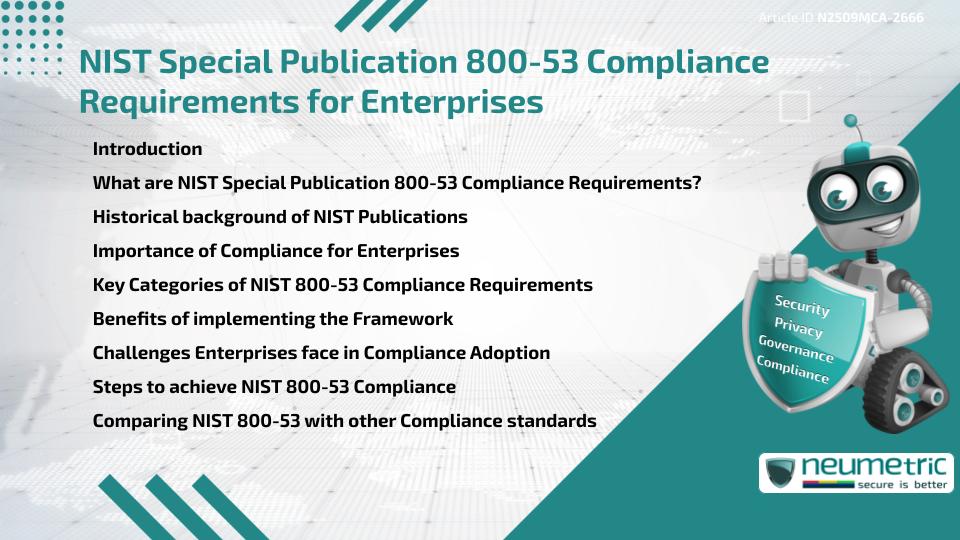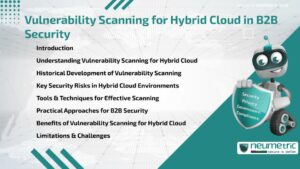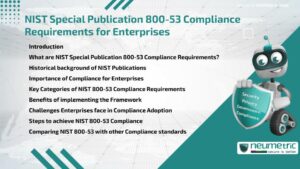Table of Contents
ToggleIntroduction
Enterprises today face increasing pressure to safeguard Sensitive Information & maintain Regulatory Compliance. The NIST Special Publication 800-53 Compliance Requirements provide a structured Framework of Security & Privacy controls to protect organisational systems. Developed by the National Institute of Standards & Technology [NIST], this publication offers detailed guidance for enterprises to meet Compliance obligations, strengthen Risk Management & align with Federal & Industry Standards. By adopting this Framework, enterprises can enhance Trust, improve Operational Security & reduce exposure to costly Breaches.
What are NIST Special Publication 800-53 Compliance Requirements?
The NIST Special Publication 800-53 Compliance Requirements represent a comprehensive catalog of safeguards designed to protect the Confidentiality, Integrity & Availability of information systems. These requirements apply to federal agencies & any enterprise that handles Government data, but they are also widely used by private Organisations seeking a robust Compliance model.
The Framework categorises Security & Privacy controls into families that cover critical areas such as Access Management, Incident Response & System Integrity. Enterprises that follow these requirements can demonstrate a commitment to protecting Sensitive Data while complying with Legal & Regulatory obligations.
Historical background of NIST Publications
The NIST 800 series has served as a cornerstone of Cybersecurity Policy since the late twentieth century. NIST introduced 800-53 to support the Federal Information Security Management Act [FISMA], ensuring federal agencies had consistent guidance on managing Security Risks.
Over the years, revisions have expanded its scope to address modern challenges like Cloud Computing, Artificial Intelligence & the Internet of Things [IoT]. This evolution has made the Framework relevant not just for Government agencies but also for private enterprises navigating complex security landscapes.
Importance of Compliance for Enterprises
Compliance is more than a Legal obligation; it is a business enabler. By adhering to NIST Special Publication 800-53 Compliance Requirements, enterprises can build Customer confidence, reduce Audit Risks & create consistent Policies across business units.
For example, an enterprise handling Government contracts must comply with NIST 800-53 to maintain eligibility. Non-Compliance could result in penalties, loss of contracts or reputational harm. In this way, Compliance strengthens both Legal standing & Market competitiveness.
Key Categories of NIST 800-53 Compliance Requirements
The Framework organises requirements into families of controls, each addressing specific areas of security:
- Access Control: Managing who can view & modify data.
- Audit & Accountability: Ensuring actions are logged & traceable.
- System & Communications Protection: Safeguarding data during storage & transmission.
- Incident Response: Defining steps to manage & report Security Breaches.
- Risk Assessment: Evaluating Vulnerabilities & prioritising defenses.
- Configuration Management: Standardising system setups to reduce Vulnerabilities.
These categories provide enterprises with a holistic blueprint for protecting information assets.
Benefits of implementing the Framework
Enterprises that adopt the NIST Special Publication 800-53 Compliance Requirements gain several advantages:
- Regulatory alignment: Satisfies federal Compliance mandates.
- Risk reduction: Identifies & mitigates Vulnerabilities systematically.
- Operational consistency: Standardises Controls across departments & locations.
- Enhanced Trust: Strengthens reputation with Customers, Partners & Regulators.
- Adaptability: Can be tailored to various enterprise environments & industries.
Challenges Enterprises face in Compliance Adoption
Despite its value, implementing NIST 800-53 is not without obstacles. Enterprises often face resource constraints, as Compliance requires dedicated staff & technology investments. The extensive catalog of controls can also overwhelm smaller Organisations.
Additionally, integrating the Framework with existing IT systems can be complex. Enterprises may struggle to balance strict Compliance with business agility, leading to delays in adoption or incomplete implementation.
Steps to achieve NIST 800-53 Compliance
Enterprises seeking to comply should follow a structured process:
- Conduct a Gap Analysis: Identify areas where current practices fall short.
- Define system boundaries: Document which Systems & Data require Compliance.
- Select applicable controls: Choose Controls relevant to organisational Risks.
- Implement safeguards: Deploy technical & administrative measures.
- Perform ongoing monitoring: Continuously assess & update Controls as Threats evolve.
- Document Evidence: Maintain thorough Records to demonstrate Compliance during Audits.
Comparing NIST 800-53 with other Compliance standards
Enterprises often evaluate NIST 800-53 alongside other frameworks like ISO 27001 & the Center for Internet Security [CIS] Controls. While ISO 27001 focuses on establishing an Information Security management system [ISMS], NIST 800-53 provides a detailed catalog of specific Security & Privacy requirements.
CIS Controls, on the other hand, are more concise & designed for rapid implementation. Enterprises may choose to integrate these frameworks, using NIST 800-53 for its depth & others for simplicity & agility.
Conclusion
The NIST Special Publication 800-53 Compliance Requirements remain one of the most comprehensive Security frameworks available to enterprises. By implementing its controls, Organisations not only achieve Regulatory Compliance but also strengthen their Security posture & build Resilience against Cyber Threats. Although challenges exist in terms of resources & integration, the long-term benefits make adoption essential for enterprises seeking to balance Compliance with effective Risk Management.
Takeaways
- NIST 800-53 outlines structured Compliance Requirements for enterprises.
- It was developed to support FISMA & has evolved with modern technologies.
- Key control families cover Access, Audit, Risk & Incident Response.
- Benefits include Regulatory alignment, Risk reduction & enhanced Trust.
- Enterprises must overcome resource & integration challenges to succeed.
FAQ
What are NIST Special Publication 800-53 Compliance Requirements?
They are a set of Security & Privacy controls developed by NIST to protect information systems & ensure Compliance with federal mandates.
Who needs to follow NIST 800-53?
Federal agencies & enterprises working with Government data must comply, while private Organisations adopt it for Best Practices.
What are the main categories of controls in NIST 800-53?
They include Access Control, Audit, Incident Response, Risk Assessment, System protection & Configuration management.
Is NIST 800-53 Compliance mandatory?
Yes, it is mandatory for federal agencies. For private enterprises, it is voluntary but widely adopted for Credibility & Security improvement.
How does NIST 800-53 compare with ISO 27001?
ISO 27001 focuses on establishing an ISMS, while NIST 800-53 provides a detailed catalog of specific Security Controls.
What challenges do enterprises face with NIST 800-53?
Common challenges include high resource demands, integration issues & managing the extensive catalog of controls.
How can enterprises demonstrate Compliance?
They can conduct audits, maintain detailed documentation & use Monitoring Tools to show that controls are implemented & effective.
Need help for Security, Privacy, Governance & VAPT?
Neumetric provides organisations the necessary help to achieve their Cybersecurity, Compliance, Governance, Privacy, Certifications & Pentesting needs.
Organisations & Businesses, specifically those which provide SaaS & AI Solutions in the Fintech, BFSI & other regulated sectors, usually need a Cybersecurity Partner for meeting & maintaining the ongoing Security & Privacy needs & requirements of their Enterprise Clients & Privacy conscious Customers.
SOC 2, ISO 27001, ISO 42001, NIST, HIPAA, HECVAT, EU GDPR are some of the Frameworks that are served by Fusion – a SaaS, multimodular, multitenant, centralised, automated, Cybersecurity & Compliance Management system.
Neumetric also provides Expert Services for technical security which covers VAPT for Web Applications, APIs, iOS & Android Mobile Apps, Security Testing for AWS & other Cloud Environments & Cloud Infrastructure & other similar scopes.
Reach out to us by Email or filling out the Contact Form…





